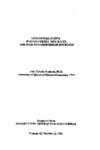Por favor, use este identificador para citar o enlazar este ítem:
http://www.alice.cnptia.embrapa.br/alice/handle/doc/1014766| Título: | Cercospora sojina: pathogenity, new races and seed transmission in soybeans. |
| Autor: | YORINORI, J. T.  |
| Afiliación: | JOSÉ TADASHI YORINORI, CNPSO. |
| Año: | 1981 |
| Referencia: | Dissertation Abstracts International, v. 42, n. 2, 1981. |
| Descripción: | The variability in Cercospora sojína (frogeye leal spot of soybeans), seed transmission and its relationship with other seedbome organisms were investigated. Sixty-six cultivars (maturity groups 00 to IX) were inoculated in the field with race 2 and nine new isolates oi C. sojina at 5 to 7 days intervals. The first inoculation was done when cultivars of maturity group 00 started to flower and deloliation was scored on day 33lrom first inoculation. Two disease rating scales were detined.(1) Based on relative number and types oi lesions: O = no lesion; 1 = reddish brown spots, 0.5 mm diameter or up to five 3 to 5 mm diameter spots/trifoliolate leal; 2 = reddish brown spots, 1 to 2 mm diameter or five to 10 spots/trifoliolate, 3 to 5 mm diameter; 3 = spots with reddish brown margin, light-brown to grayish center, 2 to 3 mm diameter or 10 to 50 spots/triloliolate, 3 to 5 mm diameter; 4 = spots with thin reddish brown margin, dark-grayish to light-brown center, 3 to 5 mm diameter and 50 to 120 spots/trifoliolate; and 5 = sarne as 4 with spots of more than 4 mm diameter and more than 120 spots/trifoliolate. (2) Baseei on percentage defoliation: O to 5% = resistant, 6 to 9% = intermediate, and more than 10% = susceptible. The nine new isolates of C. sojína were identified as seven new races and designated races 5 to 11. A set of differential cultivars with Bienville, Blackhawk, Bragg, Capital, Comet, Davis, Dorman, Flambeau, Hampton, Hood, Lee, Mandarin (Ottawa), Patoka, Roanoke, Tanner and Wabash is suggested. Percentage see infection by C. sojina (Cs) and other organisms on 29 cultivars {maturity groups 00 to IV) were determined in either of two ways. For the pod harvest (a) 16 cultivars (groups 00 to li) had ali the pods from five plants collected separately and the seeds aseptically assayed on blotters (4 layers of filter papers in 9-cm culture plates) with 15 to 17 seeds/plate; and for threshed seeds {b) 13 cultivars (groups Ili and IV) had tive plants threshed together and tive samples of 60 seeds/cultivar were assayed on blotters at 15 seeds/plate. The two harvest methods were also compareci with seeds threshed and surface-disinfected with 0.5% NaCIO. Percentage defoliation varied from less than 1 to 80% and was positively correlated with Cs and negatively with C. kíkuchíi infection (Ck), purple-stained seeds at plating {PS) and with 100-seed weight {HSW). The mean Cs varied trem O to 91.6% and was negatively correlated with Ck and HSW. Cs was most responsible for reduction in HSW. The effect of C. sojina on germination {GER) and HSW depended on infection occurring before full seed development. Mean PS varied Irem 1.7 to 15.6% and mean Ck varied from 7.7 to 47.1%. Mean Phomopsis spp. infection {Ph) varied Irem 5.2 to 80% and was the most responsible for low GER. Mean SMV seed mottling varied from O to 41.8%. SMV was higher on late-maturity cultivars, whereas, Ck, Cs and Ph were lower. Recovery of Ck, Cs and Ph from threshed and surface-disinfected seeds were significantly lower than from seeds removed from pods. The rate of seed transmission can be underestimated when seeds are surface-disinfected. |
| Palabras clave: | Soybean |
| Tipo de Material: | Resumo em anais e proceedings |
| Acceso: | openAccess |
| Aparece en las colecciones: | Outras publicações (CNPSO)  |
Ficheros en este ítem:
| Fichero | Descripción | Tamaño | Formato | |
|---|---|---|---|---|
| id358420001.pdf | 596.32 kB | Adobe PDF |  Visualizar/Abrir |









